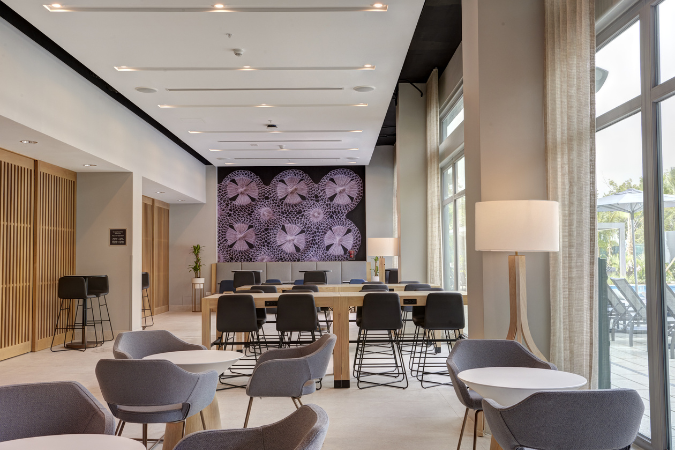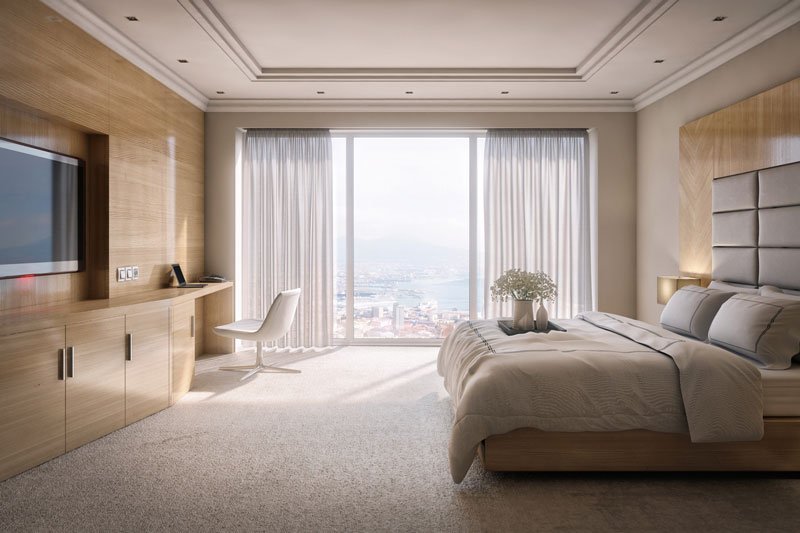
5 Ways Hospitality Design Transforms Guest Sleep
Hospitality design is evolving to go far beyond comfort—it’s becoming science-driven, wellness-centered, and personalized. Take a look at 5 key ways hospitality design is revolutionizing the way guests sleep.
6 Tips for Designing Extended-Stay Hotels
Here are some effective tips for designing extended-stay accommodations that can help create a comfortable and inviting environment for guests.
7 Innovative Hotel Design Trends to Watch for in 2024
Explore some of the innovative hotel design trends expected to redefine how we experience hospitality in 2024.
4 Ways To Design A Unique And Memorable Hotel Guest Experience
When guests walk into a hotel, the very first thing they notice is not the amenities—it's the design, the look and feel of the property.
This vibe and how it makes them feel kicks off their guest experience during a hotel stay.
Most guests notice a hotel’s style—industrial, minimalist, bohemian, country. They see wall colors, furniture, lighting fixtures and tile patterns on the floor. Maybe there's a spectacular staircase or mural in the lobby that catches their eye. Whatever they see or sense will trigger an experience.
Good design is pretty aesthetically pleasing. Great design engages the senses, lures people in and creates a visual narrative that guests will remember long after they leave. Designers' talent lies in their ability to create guest experiences that are genuine, unique, and memorable.
Resilient Hotel Design: Riding The Hurricane Wave In The Caribbean
Designing for Disaster Saves Lives and Money in the Long Run
Natural disasters cannot be prevented, but the damage they inflict on the hospitality industry can be mitigated through resilient design and adequate disaster preparedness. It is up to hotel owners and operators to take the necessary measures to safeguard their property and protect their guests, especially in regions prone to extreme weather patterns.
Sustainable Design Matters to Green Travelers and Eco-Friendly Hotel Guests
The increasing popularity of eco-friendly or green tourism is driving sustainable design in the hospitality industry to new heights.
Green travelers want to stay in green hotels, and eco-friendly guests are not likely to be persuaded to act against their values. Sustainable design offers environmentally conscious travelers a place where they can feel comfortable spending their time and their hard-earned cash.
Millennial Hospitality: Designing with Millennial Travelers in Mind
Millennials are shaping the hospitality industry (not to mention the world!)
It's the millennial revolution, and it's all about guest experience, technological conveniences, and social media.
Millennials are unlike traditional travelers. They don't travel; they explore. They crave new, unexpected, meaningful experiences. Still, why should the hospitality industry cater to them?
Designing for Brand Identity and Guest Experience
Interior design is the key to strengthening your brand and your hotel guest's experience
A physical space is an excellent place to create unique customer experiences, make a memorable impression and spark an emotional connection with customers that will elevate your brand and influence their behavior.
Good interior design may seem like a luxury, yet without it, hotels, restaurants and others in the hospitality industry are handicapped. Strategic interior design can accomplish the following and more:
How Technology is Changing Hotel Interior Design
How to Use Tech to Enhance the Guest Experience
Technology is shaping hospitality design as hotels find new ways to adapt to sociocultural changes and personalize the guest experience. Smart features and gadgets—from dimmer switches to multifunctional spaces—are showing up in hotel interior design and redefining what constitutes a good stay.
However, hotels should avoid getting carried away when creating tech-savvy interiors. Not every guest wants to "plug in" when traveling. Some actually seek to disconnect from their tech-dominated lives. As always, balance is the key.
Enhance Your Hotel's Guest Experience with Smart FF&E Interior Design
It is not enough to fill a hotel with nice decor and seating options.
With careful curation of furniture, fixtures, and equipment (FF&E), an interior designer can create a unique and authentic atmosphere that keeps customers coming back for more.
Today’s hotel guests are sensitive to good interior design. In addition to liking or not liking the look and feel of a space, they respond to design elements that make them feel comfortable, inspired, happy, relaxed or excited, often without being aware of it. They also expect to find the comforts and conveniences they have at home when they are on the road.
Architectural Design With a Sense of Place
What does it mean for a building to have a "Sense of Place"?
Through our work, we focus on giving our designs both individuality and a sense of place.
We carefully consider the geographical area surrounding a project, as well as the location's history and culture, in order to provide the absolute best experience for residents, neighbors, and visitors.
Check out how we design with a Sense of Place in our latest video!
Cuba: A Lesson in Raw Hospitality
Is experience creation the new reality in the hospitality business?
For the greater part of the twentieth century, the hospitality industry focused on creating cocoons of comfort where travellers could repose, nurture, and refresh themselves, while safely exploring the exoticism of other cities, cultures, and customs.
The goal of the hospitality industry at the time was simply to create a safety zone where one might dip one’s toe in a bit of strangeness during the daytime— with the guarantee of a warm bed and an equally warm (and recognizable) meal at night.
















